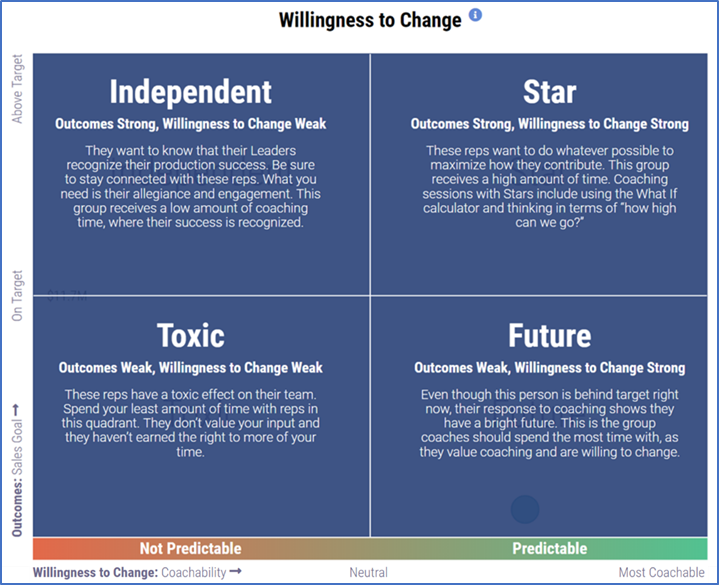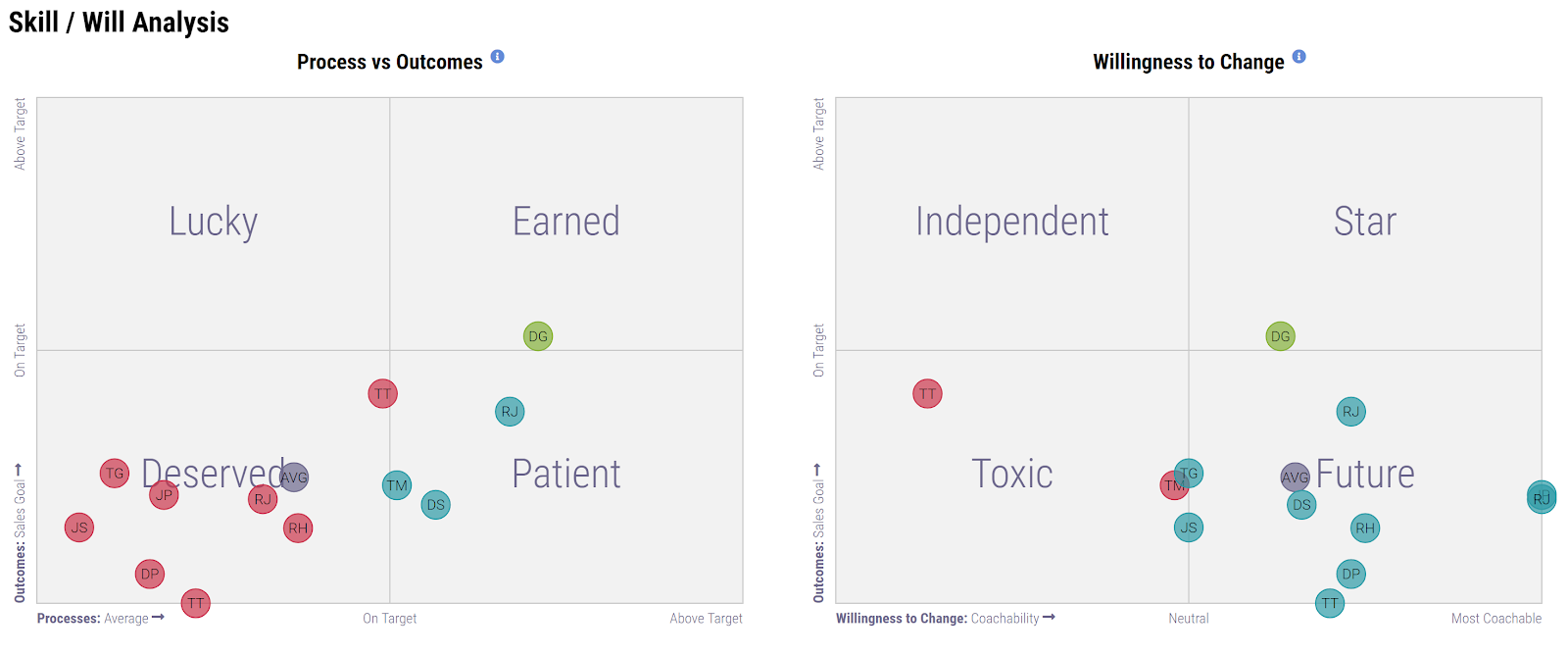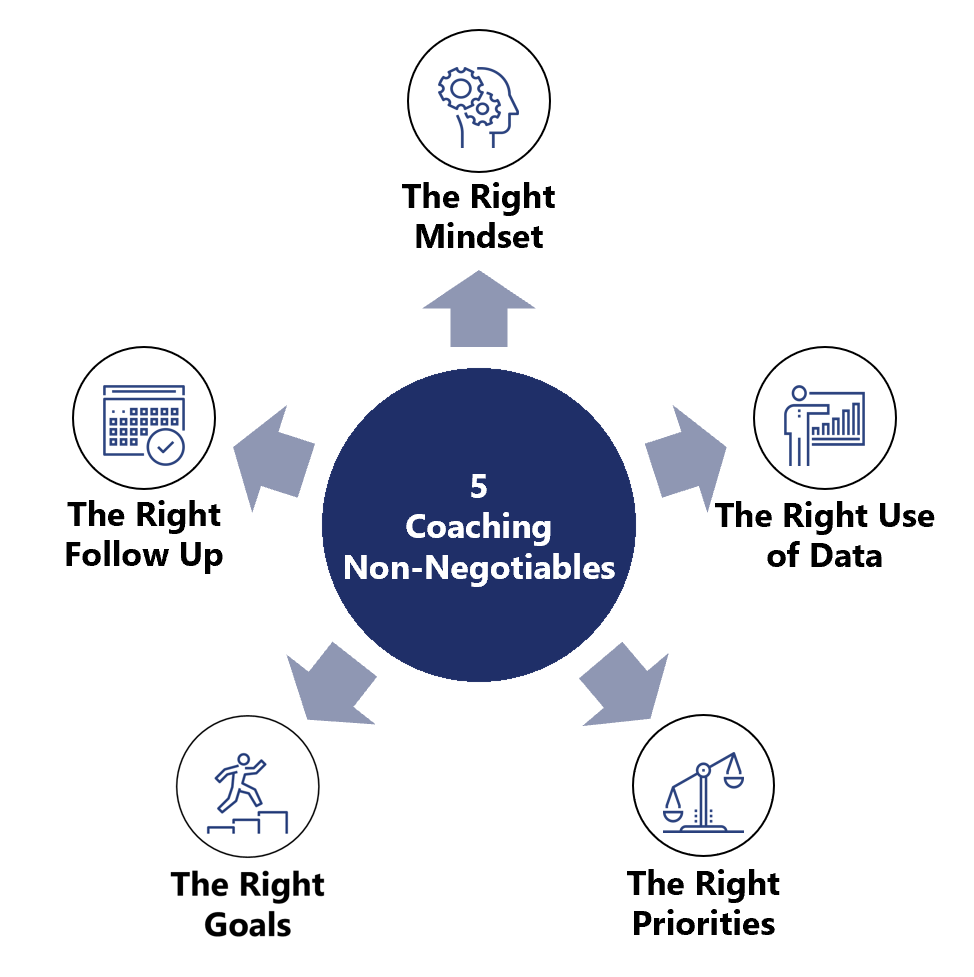This final part of the 5-part sales coaching series focuses on coaching for sales success.
Part 5 Overview:
- Commitments vs. Conversations
- Coaching vs. Conversations
- Salespeople Stay Where They Are Celebrated, Not Tolerated
- Use Follow-Up Meetings to Calibrate Your Rep’s Strengths
- The Coachability Quadrants
- The 8 Types of Salespeople in EVERY B2B Team
- If Process Drives Outcomes, What Drives Process?
- How to Allocate Time Based on the Coaching Quadrants
- Coaching for Sales Success: Developing Your Own Model
- 5 Things You Can Expect with Top-Notch Sales Coaching
1) Commitments vs. Conversations
A coaching study released in August 2018 identified that 48.2% of sales reps say they don’t receive coaching.
Surprisingly, 82.1% of the sales leaders of these reps claim they are providing coaching for each member of their team. This gap points out the importance of the 1:1 between leader and rep creating what the rep perceives as a “coaching moment.”
Coaching happens when leaders and reps move past conversations and make commitments to change. Too often what leaders think is great coaching, a rep perceives as nothing more than a suggestion.
Why coaching 1:1s need to include commitments
No commitment, no change.
I was speaking with a high-performing rep of a team that recently started a structured coaching program. This was his answer when I asked him what the biggest change was:
“Before we’d have 1 on 1s and I’d have a good conversation with my leader. She would make suggestions and I’d leave and go about my business. Sometimes I’d apply the suggestions better than others. The conversations were good and they built a relationship I appreciated. But I didn’t feel like I was “on the hook” to do anything different.”
“With the coaching plan, once I saw the email come confirming my commitment to modify my approach, I felt a responsibility to make sure I made it happen. This led to me applying the coaching points immediately. I blew past the coaching goal and had one of my most successful months!”
“Having that commitment made all the difference. This also changed my expectation of what to expect in these sales meetings with my manager. Now I come with ideas on what I think I need help with rather than showing up wondering what she will talk about in this meeting.”
2) Coaching vs. Conversations
The study referenced earlier teaches us some big lessons:
- Salespeople WANT coaching. This is particularly the case with the incoming sales generation.
- Most of the time, salespeople don’t interpret the conversations with their leaders as “coaching” sessions.
- When they think they are getting coaching, 80% of the time, they follow the coaching advice and keep their coaching commitments.
Reps need to know when coaching begins and high-level conversations end
Every rep needs to know they are making commitments to change.
Because if they do, 80% of the time they will keep the commitment.
So what’s in a commitment?
Commitments include the following attributes:
- WHAT the rep is going to change.
- HOW it will be measured.
- WHEN it will be completed and reviewed.
Every 1:1 needs to create those “Fork in the Road” moments described in Part 4 of this series.
Perhaps the most important part of this is an agreement to when the commitment will be reviewed and measured.
Sales goals vs. coaching goals
A distinguishing factor of a coaching goal is the only person that has to say “yes” is the salesperson. This is different than sales goals.
Sales goals require a customer to say yes. They have to agree to buy.
Coaching goals only require the salesperson to agree to change. She or he agrees to do more specific activities, develop a unique skill, or use a company resource. The rep is 100% in charge of the success or failure of these goals.
As a result, the first part of every 1:1 should be to review the existing coaching goals.
This leads to a rhythm of change: Commit, Execute, Follow Up, Repeat.
3) Salespeople Stay Where They Are Celebrated, Not Tolerated
Great leaders use the 1:1 as an opportunity to celebrate.
You should know if a rep has achieved their coaching goal before you meet with them. If they’ve achieved the goal, take time to hear their story. Understand the challenge associated with making the change and listen to the stories associated with the effort.
One of the strongest passion factors for a salesperson is unexpected rewards. Find ways to reward the reps that are achieving their coaching goals.
Shout-outs, commendations, discretionary awards, and primo leads are simple ways you can provide unexpected rewards for the reps trying to change.
But don’t just check the box and say thanks. Make sure you relish the moment with the reps working to make a change.
4) Use Follow-Up Meetings to Calibrate Your Rep’s Strengths
Your follow-up meeting provides a critical opportunity to calibrate the rep’s strengths in your sales process and their commitment to change. There are two calibration points your follow-up conversation needs to include.
Calibrate impact
It’s important to calibrate the effect of the change on the sales process. If you are setting effective coaching goals, the change the rep makes should result in something measurable in the sales process.
There are four leverage points for any B2B sales process.
Coaching should improve one of these four drivers of growth:
- Number of new opportunities
- Revenue per customer
- Win rate
- Sales cycle time
Good coaching + good execution = predictable process improvements. If the rep is achieving their coaching goal, be sure to evaluate if the change is driving change in the process.
If change as a result of coaching doesn’t show up in one of these metrics, find out why.
Calibrate coachability
If you are setting coaching goals, you can measure coachability. Either a rep chooses to achieve their coaching goals, or they don’t. Every coaching goal should be a specific activity to change or a specific skill to develop.
With this understanding, every coaching goal can help you measure whether the rep did or did not respond to coaching. After making their commitment, if they keep it, they get a positive score. If they don’t keep the commitment, they get a negative.
5) The Coachability Quadrants
In Part 3 of this series, we suggest a framework for measuring strength in the process. By evaluating coaching goal histories, you can also implement a framework for measuring willingness to change.
By calculating the coachability score using the +/- system you can quickly gain insight into how responsive a rep is to coaching.
As in the earlier quadrant, the up/down axis is a rep’s year-to-date progress to their goal. On the crosshair = hitting goal. Above the line = beating goal and below the line = missing goal.
The left/right axis measures the rep’s coachability. On the axis means they are neutral in achieving coaching goals. To the right = positive coachability. To the left = negative coachability.
This creates four additional quadrants:

Outcomes weak, coachability weak: Toxic
Reps in this quadrant are not hitting their goal and they are unwilling to change.
They make a commitment in a 1:1 but don’t change their approach. Goals in the 1:1s need to be activity-oriented and create an expectation of what the expected effort is to stay part of the team.
These reps often are a source of bigger problems than missing their number — they often become a source of toxicity to the team.
Outcomes weak, coachability strong: Future star
Reps in this quadrant are not hitting their goal but they are responding well to coaching conversations. 1:1s with these reps should be centered around the key parts of the process that will help them create strong, predictable sales pipelines.
Generally, this means either creating more pipeline or having more success moving opportunities with higher win rates or shorter cycle times.
Stay close with these reps as they are demonstrating a willingness to improve and they appreciate and value coaching.
Outcomes strong, coachability weak: Independent
Reps in this quadrant are achieving their goals but resist changing their approach.
This most often is seen with reps that have longer tenure with the company or in sales. In these cases, it is important to refer to their process quadrant and see if they are in the lucky or earned category.
Reps in this category often respond well to discussions around “How good can you get?”
It’s very important to dollarize the impact of even the smallest changes and tap into their aspirational goals.
As a leader, these are the reps that you need to have “so-what” conversations with as discussed in Part 3 and Part 4 of this series.
Outcomes strong, coachability strong: Star
Reps in this category are achieving their goals and they respond well to change.
To be a leader in an organization you must be able to adapt and respond to change. That’s why the reps in this category are your future sales leaders/managers.
They welcome the “what if” conversation and often come to the 1:1 with their own ideas of what they want to improve. Provide context and insight and help them chart their course.
This chart is easy to use and helps a rep understand their response to coaching:
6) The 8 Types of Salespeople in EVERY B2B Team
By tracking coachability this way, a leader has a powerful tool. By placing the process and coachability quadrants side by side, a leader has a three-dimensional view of each rep on their team:

This creates eight types of salespeople in each sales organization:
- Deserved + Toxic: Poor outcomes, weak process, and unwilling to change.
- Deserved + Future: Poor outcomes, poor process, but responding to change.
- Patient + Toxic: Poor outcomes, strong process, but resistant to change.
- Patient + Future: Poor outcomes, strong process, and responding to change.
- Lucky + Independent: Strong outcomes, weak process, and not responding to change.
- Lucky + Star: Strong outcomes, weak process, but responding to change.
- Earned + Independent: Strong outcomes, strong process, but not responding to change.
- Earned + Star: Strong outcomes, strong process, and responding to change.
The 1:1s for each of these reps will be different. You will have different conversations, set different goals, and spend different amounts of time with each one.
Your expectations can be tailored and a rep can understand why each coaching goal is relevant and necessary.
Some reps need specific, activity-oriented goals. Others will respond to the bigger picture — more strategic initiatives.
7) If Process Drives Outcomes, What Drives Process?
Measuring coachability is often the missing link for a sales leader. The concept of the process driving outcomes is well-established and understood.
If the process needs to change then a rep needs to be coachable. Markets change, customers change, companies change, and products change. Being resistant to change only leads to unnecessary challenges. The kinetic chain every sales leader can count on is simple:
Outcomes are driven by Process, Process is driven by Coachability.
Every sales leader measures outcomes. Most measure process. Few measure coachability.
Measure it and you’ll have one of the most valuable tools most sales leaders never are able to use.
8) How to Allocate Time Based on the Coaching Quadrants

One of the most common mistakes sales leaders make is allocating equal time to each rep. Measuring coachability helps you avoid the “Time Trap.”
Your time is your most precious resource. So which reps should you spend your time with?
The obvious answer: FUTURE.
These are reps that are missing goals but respond to coaching. But who gets the next most amount of time? The answer may surprise you. STARS.
Many mistakenly prioritize the toxic category simply because they are under-performing. By measuring coachability you can see the reps that value your time as a coach. You should maximize every minute you can with the reps that value and respond to coaching.
Toxics get a 1:1 and not much more.
Once a Toxic teammate starts hitting their coaching goals they will quickly swing to the Future category. Then you have time for them in spades.
This is why you want to use an emotional label like Toxic. Don’t make it politically correct to under-perform AND be unwilling to change. Remember, Toxic only applies when a rep says they are going to do something and then choose not to.
9) Coaching for Sales Success: Developing Your Own Model
This series has identified the 5 drivers of coaching success:

- Developing the right coaching mindset
- Using data like a pro
- Being a sales performance coach
- Setting the right goals for sales reps
- Following up for sales success (Part 5)
These are the hallmarks of the world’s most successful sales coaches. Implementing these drivers in a consistent way will create intentional improvement with each rep willing to commit to coaching.
Applying a Successful Sale Coaching Model
A market leading financial institution recently applied this coaching model to its sales organization. The organization was already a high-performer experiencing some of their best performance in company history.
At the end of a reporting period, a strategic team with nearly 50 salespeople had beat their goal by 20%. In most cases, this would be cause for celebration.
This team beat their goal by 20% with only 22% of their salespeople hitting the goal.
At the end of the reporting period the team looked like this:

59% of the team was in the poor category and only 8 reps were hitting goal.
The team implemented the coaching system described in this series and in 90 days experienced a complete transformation:

24 in the poor category became 10.
5 in the star category became 17.
20% ahead of goal became 191%
All because 22% hitting goal became 58%, and the entire team shifted up.
In 90 days.
No new salespeople or training. Just segment-based, commitment-driven coaching.
But the real success is the lives that were changed because they had coaches that fully committed to their success. The business case for coaching is strong enough that every sales team can build the case to invest in coaching. It might be the most ROI-positive decision a leader can make.
10) 5 Things You Can Expect with Top-Notch Sales Coaching
We’ve found that AT LEAST five predictable outcomes happen with great coaching:

- Production (Sales) increases by 30%.
- Productivity (% of reps hitting goal) increases by over 20%.
- Salesforce (CRM) utilization increases by 95%.
- Retention and engagement of salespeople increases by over 20%.
- Win rates increase by over 25%.
Coaching is the lever that helps a sales organization grow faster and more efficiently than any other lever they can turn to.
Got questions about coaching? Want to kick ideas around or discuss best practices? Use these principles. Your team will thank you. Or you can hit me up.
Other Guides in This Sales Coaches Series
This guide is part one of a 5-part series on Sales Coaching. Don’t miss the other guides in the series:
- The Right Mindset
- Data-Driven Sales Coaching
- Prioritizing with Sales Performance Coaching
- Setting the Right Goals for Sales Reps
- Coaching for Sales Success



